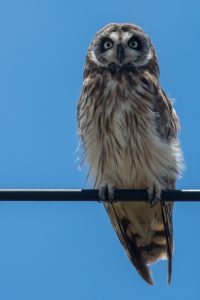Pueo
Names
- ʻŌlelo Hawaiʻi: Pueo
- Common: Hawaiian Short-eared Owl
- Scientific: Asio flammeus sandwichensis
Song
Conservation Status
- State listed as Endangered on O‘ahu
- State recognized as Endemic at the subspecies level
- NatureServe Heritage Rank G5/T2 – Species secure/Subspecies imperiled
Species Information

Pueo. PC: Alex Wang
The pueo, or Hawaiian short-eared owl, is an endemic subspecies of the nearly pandemic short-eared owl (Asio flammeus; Family: Strigidae). The species is thought to have colonized the Hawaiian Islands sometime after the arrival of Polynesians. Unlike most owls, pueo are active during the day (i.e., diurnal), and are commonly seen hovering or soaring over open areas. Like short-eared owls in continental environments, those in Hawai‘i primarily consume small mammals. Their relatively recent establishment on Hawai‘i may have been tied to the rats (Rattus exulans) that Polynesians brought to the islands. Little is known about the breeding biology of pueo, but nests have been found throughout the year. Males perform aerial displays known as a sky dancing display to prospective females. Nests are constructed by females and are comprised of simple scrapes in the ground lined with grasses and feather down. Females also perform all incubating and brooding. Males feed females and defend nests. Chicks do not hatch at the same time and are fed by female with food delivered by male. Young may fledge from nest on foot before they are able to fly and depend on their parents for approximately two months.
Distribution
Found on all the Main Hawaiian Islands from sea level to 2,450 meters (8,000 feet).
Habitat
Pueo occupy a variety of habitats, including wet and dry forests, but are most common in open habitats such as grasslands, shrublands, and montane parklands, including urban areas and those actively managed for conservation. Because of a lack of historical population data and the species’ current, broad habitat use, key habitat variables are difficult to determine. Pueo occur in many areas that are managed by the Sate of Hawai‘i or Federal agencies.
Threats
Pueo are likely susceptible to the same factors that threaten other native Hawaiian birds, including: loss and degradation of habitat, predation by introduced mammals, and disease. However, their persistence in lowland, non-native and rangeland habitats suggests that they may be less vulnerable to extinction than other native birds, especially because they may be resistant to avian malaria (Plasmodium relictum) and avian pox (Poxvirus avium). Despite this, for pueo populations, the following are of particular concern:
- “Sick owl syndrome”. Mortality on Kaua‘i has been attributed to this syndrome, which may be related to pesticide poisoning or food shortages.
- Predation. Because pueo nest on the ground, their eggs and young are vulnerable to predation by rats (Rattus spp.), cats (Felis silvestris), and the small Indian mongoose (Herpestes auropunctatus).
- Habitat loss. May be particularly important to O‘ahu pueo populations.
- Contaminants or toxins. Because pueo are top predators, fat-soluble contaminants may accumulate in prey species; may be related to “sick owl syndrome” (see above).
- Human interaction. Hunting behavior and habitat use predispose pueo to vehicular collisions, which have been documented on Lāna‘i and the island of Hawai‘i.
Explore from Home
Plans & Projects
Additional Resources
For more information and references visit the DLNR State Wildlife Action Plan factsheets. DOFAWʻs species pages and State Wildlife Action Plan fact sheets are provided for general information and are not meant to be a citable, original source of data. If you are a student, researcher, or writer looking for a citable source, please explore the references below or find other original data sources, rather than citing these webpages. The references below were provided by the authors of the State Wildlife Action Plan fact sheets at the time of drafting:
- Berger AJ. 1981. Hawaiian birdlife. Honolulu: University of Hawai‘i Press. 260 pp.
- Holt DW, Leasure SM. 1993. Short-eared owl (Asio flammeus). In The Birds of North America, No. 62 (Poole A, Gill F, editors). Philadelphia, (PA): The Academy of Natural Sciences; and Washington DC: The American Ornithologists’ Union.
- Mostello CS, Conant S. In prep. Diets of native and alien apex predators in Hawai’i.
- NatureServe. 2003. Downloadable animal data sets. NatureServe Central Databases. Available at: https://www.natureserve.org/getData/vertinvertdata.jsp (August 10, 2005).
- Scott JM, Mountainspring S, Ramsey FL, Kepler CB. 1986. Forest bird communities of the Hawaiian islands: their dynamics, ecology and conservation. Lawrence, (KS): Cooper Ornithological Society.


